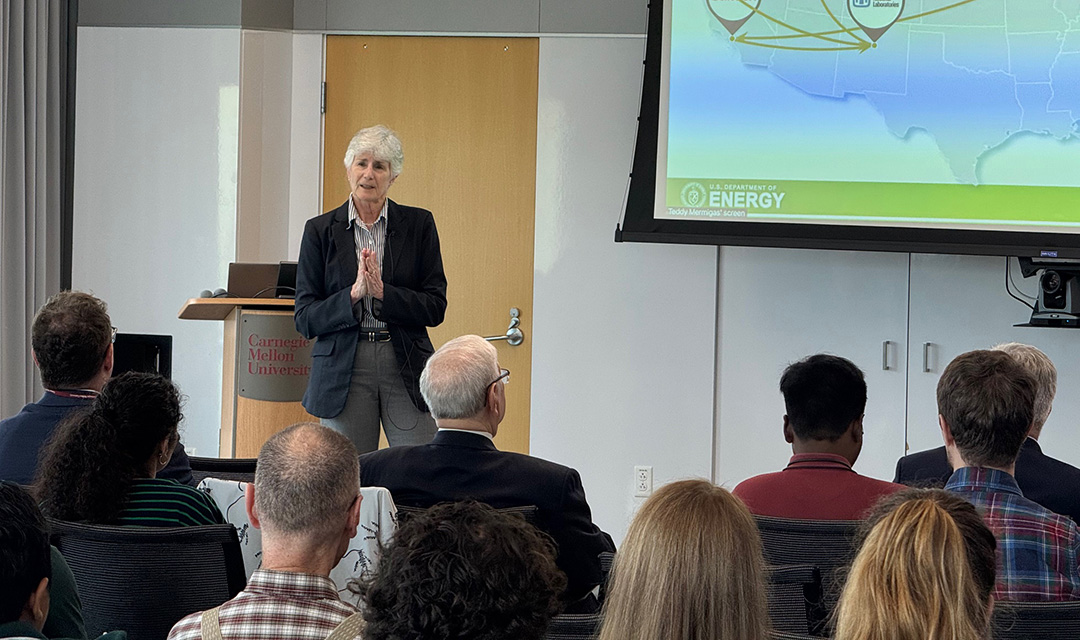Scott Institute strengthens partnership with NETL
Giordana Verrengia
Oct 1, 2024

On September 25, the Wilton E. Scott Institute for Energy Innovation at Carnegie Mellon welcomed Marianne Walck to campus for the latest installment of its Distinguished Lecture Series. As the new director of the National Energy Technology Lab (NETL), Walck's participation marked the start of a new chapter in what's been a fruitful, decades-long history between NETL and CMU.
Ed Rubin was among the very first faculty to collaborate with NETL.
"From a long term perspective, working with NETL has been an evolution. The relationship started with a few faculty members with individual projects that were deemed successful and interesting," said Rubin.
Reflecting on the establishment and growth of this partnership, Rubin noted that energy first became a marquee issue in the 1970s against the backdrop of a national oil embargo and the resulting price hikes. National interest turned towards coal production as an alternative, kickstarting a wave of research and development.
One of the pioneering collaborations was a research project led by Rubin in 1983 to develop the Integrated Environmental Control Model (IECM)–a unique and powerful computer modeling tool that continues to be used worldwide forty years later to analyze advanced low-carbon options for electric power and related industries, paying particular attention to variables like performance, emissions, costs, and uncertainties.
After establishing strong ties to CMU and other area universities, the NETL Regional University Alliance (RUA) was formalized in 2010 and also counted the University of Pittsburgh and West Virginia University among its partners. The RUA prioritized research in the areas like energy systems dynamics, materials science and engineering, and computational science and engineering.
"We had a five-year period under the RUA where we had an enormous growth in funding and the number of people who were involved in research," said Rubin.
Andrew Gellman, Lord Professor of chemical engineering and co-director of the Scott Institute, also served as the RUA's consortium director.
"Establishing the RUA made a vast difference to the NETL's publication rate of technical papers. By the program's last year, we had multiplied up to about 250 papers. There were a lot of good things that happened," said Gellman.
Among the many achievements supported by the consortium, John Kitchin received the Presidential Early Career Award for Scientists and Engineers (PECASE) from the National Science Foundation in 2011, regarded as the highest honor bestowed by the U.S. government for the field's emerging professionals. Kitchin, a professor of chemical engineering, was lauded for research that he completed under the RUA, particularly his advances in electrochemical separations for carbon capture and in computational simulation of metal catalyst reactivity.
NETL's social and scientific contributions are unique and transformative with direct impact for Pennsylvania and the greater region.
Grigorios Panagakos, Assistant Research Professor, Chemical Engineering
There's also a strong pipeline between CMU and NETL, as many alumni have gone on to provide impact at a national level in professional roles. Among many examples, David Morgan, who earned his Ph.D. in engineering and public policy at CMU, has worked at the lab for nearly 15 years as a physical scientist. Elsewhere, Joe Marriott and Hari Mantripragada, who also earned doctorates in engineering and public policy, now work for KeyLogic Systems, the site-support contractor that assists NETL. Additionally, Grigorios Panagakos was a research engineer at NETL before becoming an assistant research professor of chemical engineering at CMU. His involvement with the lab is ongoing.
"NETL has been a wonderful research partner and funding supporter consistently throughout the years," said Panagakos. "NETL's social and scientific contributions are unique and transformative with direct impact for Pennsylvania and the greater region."
Walck's first visit to campus as director highlighted renewed efforts under her leadership to develop agreements with universities and increase student and faculty engagement through research, joint appointments, and internship and fellowship programs.
NETL's workforce fosters interdisciplinary collaboration, a common trait with CMU. The lab's roughly 1,900 employees include scientists, engineers, economists, postgraduates, and graduate and undergraduate interns, all of whom make impactful contributions.
"The fun is in making connections among researchers, which makes bigger things happen," Walck said.
For media inquiries, please contact Giordana Verrengia at gverreng@andrew.cmu.edu.
